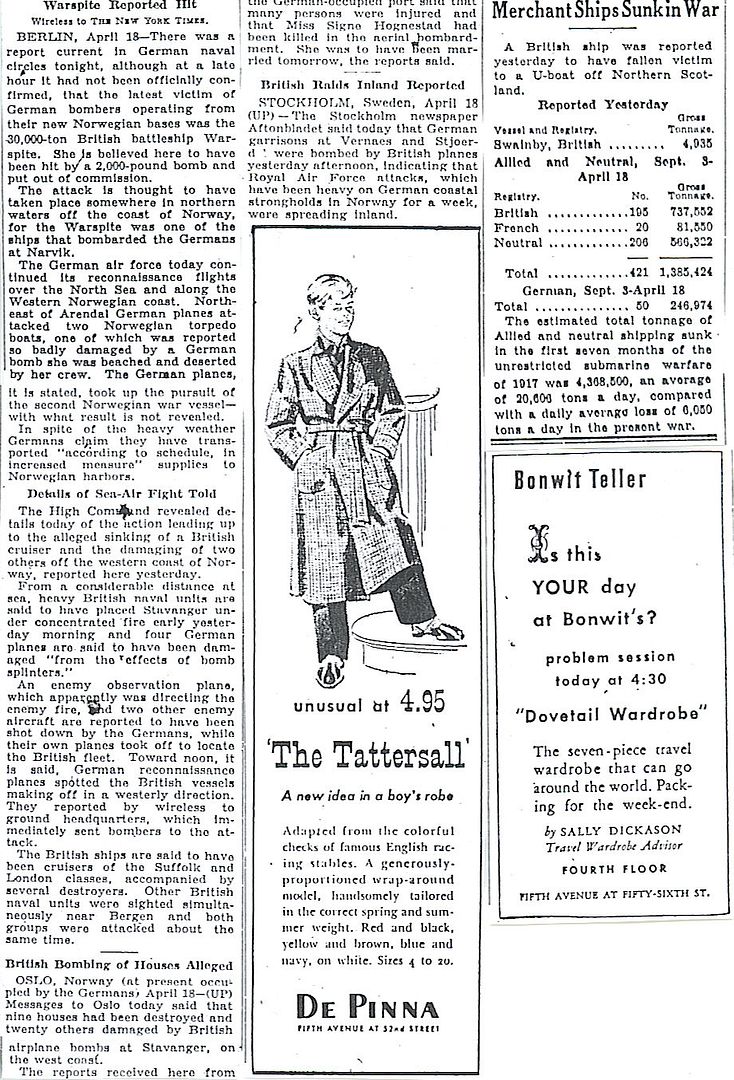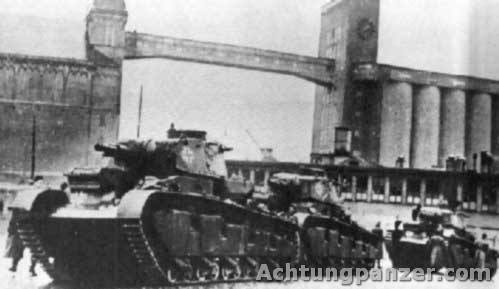
Posted on 04/19/2010 5:15:36 AM PDT by Homer_J_Simpson







There’s so much I never knew about Norway in the war.
http://www.onwar.com/chrono/1940/apr40/f21apr40.htm
Germans capture Lillehammer
Sunday, April 21, 1940 www.onwar.com
In Norway... The Norwegian forces are pushed out of Lillehammer by German attacks on both sides of Lake Mjösa. There is fighting near Namsos, Trondheim, and Narvik.
Well I certainly hope we can capture it back before the 1994 Winter Olympics.
http://homepage.ntlworld.com/andrew.etherington/month/thismonth/19.htm
April 19th, 1940
UNITED KINGDOM:
RAF Bomber Command: Reconnaissance - Hamburg. 51 Sqn. (Armstrong Whitworth Whitley IVs from Dishforth, Yorkshire) Task carried out as briefed. Considerable searchlight activity, but Flak negligible.
RNAS Hatston: poor weather results in no missions today.
NORWAY:
The country becomes a Reichskommisariat, led by Joseph Terboven under the control of the German Foreign Office.
Lofoten Islands: A force of British and French troops have landed at the Lofoten Islands, off Narvik. The aim of the Lofoten Islands force is to take Narvik. Maj. Gen. Macksy’s force includes the French 5th Demi-Briage of Chasseurs Alpins - specialists in mountain warfare. However, the French have been dogged by trouble. Their convoy had been bombed by the Luftwaffe, one escorting destroyer was so badly damaged that it had to put back to France. When they reached port and began unloading cargo they discovered that their skis were useless - they had been shipped without bindings.
The British 148th Brigade at Åndalsnes under Brig. Gen. Harold de Riemer Morgan loads his troops onto trains to carry them the 60 miles inland to Dombas. From Dombas he intends to turn north to Trondheim, as he had been instructed to do. But General Ruge, who was eagerly awaiting their arrival, had a more pressing need for the British. “My men are near exhaustion,” he told Morgan, and he warned that the Norwegian positions to the south were in danger of imminent collapse unless the British general rushed troops to their assistance.
The appeal seemed logical. If the British advanced northward and the Norwegian positions fell, the Germans could readily cut the only supply line from Åndalsnes to Dombas. The British would be stranded in unfamiliar terrain, wedged between the German garrison at Trondheim and the advancing spearheads of the German troops from Oslo. Morgan orders to his men south 80 miles to Lillehammer, and take up positions to the south of the city.
The British 146th Brigade retreats from Steinker towards Namsos.
(Mark Horan adds):
Off NORWAY:
HMS Furious had expected to finally get fully refuelled from the newly arrived tanker War Pindari (5,559 BRT), but the need to get underway in the face of two air attacks left little doubt that Tromsø was no longer a safe haven. Abandoning further efforts, she put to sea at her best speed on three shafts, 20 knots. That afternoon, having received word (errantly) that five German destroyers were at sea, a single Swordfish was send off on an armed reconnaissance mission ahead of the ship. The aircraft, 818 Squadron’s U3K, became entangled in a snowstorm and was unable to return home. The crew navigated to Skogsfjord where they force-landed in a snowy field. The aircraft was recovered by Norwegian Navy personnel and taken to Skattoia, while the flight crew, Lieutenant(A) S. Keane, RN (P), Lieutenant A. S. Marshall, RN (O), and Naval Airman F. Clark, RN (AG) eventually reached friendly forces.
ATLANTIC OCEAN/The Clyde: HMS Ark Royal in company with the destroyers HMS Westcott and HMS Bulldog are en-route to the Clyde. HMS Glorious docks at Greenock and begins loading stores and equipment for 263 Squadron, RAF.
GERMANY:
Berlin: Jodl notes in his diary - ‘Renewed crisis. Political action has failed. Envoy Brauer (the German minister in Oslo) is recalled. According to the Fuhrer, force has to be used...’ The conference at the Chancellery becomes so embittered, with the heads of the three services blaming each other for the delays, that even the lackey Keitel stalked out of the room. ‘Chaos of leadership is again threatening,’ Jodl noted.
U.S.A.: The Japanese government advises the US that it has no aggressive intentions against the Netherlands East Indies. (Jack McKillop)
The articles claim HMS Warspite was damaged by a British bomb. I’ve been reviewing my sources and cannot find any confirmation of bomb damage to Warspite or any other British battleship. It seems odd that the British appeared to confirm the report. Anyone have more info?
The British got far more than their money’s worth for HMS Warspite. She may have seen more combat and been in more active operations than any other battleship built.
http://worldwar2daybyday.blogspot.com/
Day 232 April 19, 1940
General de Wiart’s 146th Brigade joins Norwegian forces at Steinkjer, at the Northern end of the Trondheimfjord, and also pushes forward 10 km to Verdal. They are met by German 138th Gebirgsjäger Regiment, advancing North from Trondheim. This is the first engagement between British and German land forces.
Further South, Brigadier Morgan meets Norwegian General Ruge, at Ruge’s HQ in Øyer, near Lillehammer. German 196th Division takes the towns of Hamar and Elverum only 50 miles South. Morgan is persuaded to abandon his orders to move on Trondheim and instead instructs 148th Brigade to advance from Åndalsnes, 200 miles Southeast down the Gudbrandsdal to reinforce Ruge’s troops blocking the German advance from Oslo.
Overnight, 3 battalions of French Chasseurs Alpins (mountain infantry) arrive at Namsos, to reinforce 146th Brigade, but their skis, mules, trucks and anti-aircraft guns do not. When their skis do arrive, they lack straps and are useless.
3 prototype Neubaufahrzeug heavy tanks (35 tons, three turrets with 75 mm main and 37 mm secondary gun) arrive in Oslo and are paraded through the streets to intimidate the locals, before joining the drive to Trondheim.
The Fallschirmjägers at Dombås surrender, surrounded, outnumbered, out of ammunition and bombarded by a railway howitzer. Of 185 that parachuted in, only 45 survive. Oberleutnant Schmidt has remained in command despite serious wounds to the hip & stomach. He will survive and receive the Knight’s Cross of the Iron Cross on 24 May.
This is what I have from the First Lord of the Admiralty on the 19th:
The First Lord of the Admiralty gave the War Cabinet details of naval operations off Norway.H.M.S. Furious, whilst off Tromso, had sustained slight damage to her turbines from a near miss.
The damaged caused to H.M.S. Suffolk when returning from the bombardment of Stavanger had been serious and she was now beached at Scapa. He feared that it would be some time before she would again be available for service.
The H.M.S. Renown had suffered slight damage in her encounter with Scharnhorst and would be away from service for a short time.
The survivors from H.M.S. Hardy were due to reach London that evening and suitable arrangements had been made to welcome them.
H.M. Submarine Sea Lion had reported that 2 darkened ships had been approached in the East Coast mine barrier on the 2nd April, but had escaped owing to hight speed.
The Polish Submarine Orzel had reported that she had sun, the German ship Rio de Janeiro (5,260 tons) on the 8th of April, east of Chritiansand (South).
For the 20th, I have even less.
The First Lord of the Admiralty gave particulars of the movements of H.M. Ships.H.M.S. Cairo had reported that she had been uncucessfuly attacked by enemy aircraft off Namsos 6 P.M. the previeous evening. H.M. ships Auchland, Afridi, and Arethusa had also been unsuccessfully bombed early on the previous morning.
The French cruiser Emile Bertin, which had been escorting the first French convoy, had been attacked by an aeroplane off Namsos at 6 P.M. on the 19th April and had been damaged by one hit. She would have to be docked.
I did find this reference to the Warspite on the 20th of April in a War Cabinet brief on "Operations in Norway".
8. It is not possible to deprive Narvik of its battleships at the moment we have urged strenuous action. WARSPITE has therefore been ordered to return. Some further reinforcement will be required for Narvik, which must be studied at once. The Canadians should be considered.
From what I can tell, if the Warspite was hit by anything, the damage must have been very slight.

PzKpfw NbFz VIs in Oslo, April 19th of 1940.
 Soviet T-35
Soviet T-35
I posted a picture of one of these during the Winter War postings and played hell trying to identify it. It was on the Finnish museum site calling it just a “Soviet Tank”. It was a 5 turret monster that was supposed to be used for breaking enemy strong points. I think it is pretty telling that that these tanks are not as memorable as the T-34 or the Tiger.
German production of oil is 25 million barrels, but the consumption is 60 million barrels.
Interesting, they needed the oil and coal to keep the Wehrmacht alive.
HOMER, what an education you bring to all of us.
I only read about the American involvement and did not realize how northern Europe suffered. Especially Finland against the Russians. They did kick ass early on during the winter war.
thanks to the few others that contribute, CougarGA7, dfwgator and others.
Why did I post the 4/21 onwar info on 4/19?
http://www.onwar.com/chrono/1940/apr40/f19apr40.htm
Germans ships support advance
Friday, April 19, 1940 www.onwar.com
In Norway... The units of the British 146th Brigade which have advanced from Namsos to Steinkjer are forced to retreat by German troops who have support from the warships in Trondheim Fiord.
Disclaimer: Opinions posted on Free Republic are those of the individual posters and do not necessarily represent the opinion of Free Republic or its management. All materials posted herein are protected by copyright law and the exemption for fair use of copyrighted works.